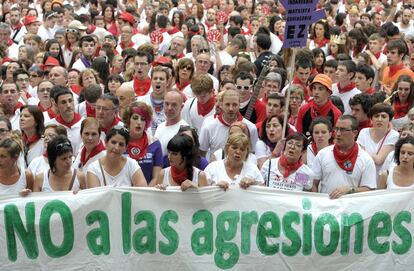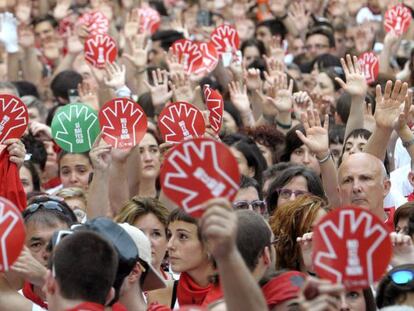Pamplona takes action to prevent sexual assaults at Running of the Bulls
City beefs up police presence after sharp rise in official complaints in 2016

Complaints related to sexual offenses increased fourfold at last year’s Sanfermines, the world-famous “Running of the Bulls” celebration held in Pamplona, northern Spain each July. And experts believe that many more cases go unreported.
In a bid to combat sexual abuse during the festival, which officially begins today at noon and ends at midnight on the July 14, police presence on the streets of the Navarrese capital has been beefed up with an 500 extra officers compared to 2016.
Around 3,500 members of the Spanish National Police, the regional police force and local law enforcement will be tasked with keeping the peace in a city whose population is expected to swell from 200,000 to one million over the next few days.
There are more reports because there is more support, but it is still the tip of the iceberg
Geno Otxando, Navarre Equality Institute
Most of the women who reported cases of abuse in the past were Spanish nationals who had come to Pamplona from other parts of the country. As for the assailants, there was a predominance of French nationals with no prior criminal record. As a result, members of France’s Gendarmerie and National Police will also be patrolling the streets of Pamplona.
More patrols will be sent out to parts of the city with a higher record of sexual assault during past Sanfermines, notably the historical district of Casco Antiguo.
Five men from Seville are awaiting trial in the fall over their involvement in the gang rape of an 18-year-old woman in the early hours of July 7, 2016. It was the most serious of the 19 cases of sexual assault that were reported last year, and prosecutors are seeking a 22-year prison sentence for each one of them.
The 2008 murder of a young nurse named Nagore Laffage by a man with whom she refused to have sex shook Pamplona’s society and triggered a citizen response to a reality that had gone largely ignored until then: the sexual abuse of women during the fiestas.

What began as activism by feminist groups became government policy in 2013, when the Navarre Institute for Equality (INAI) created a red-hand symbol representing the message “No is no.” This is the slogan that is now widely seen on posters, flags, and stickers throughout the city.
“No is no, and a yes can become a no 10 minutes later if I don’t like what’s going on,” insists Geno Otxando, an official at INAI, who says that as a result of their campaign “people now come out in defense of an assaulted woman and give her assistance.”
Police records show that, even as the population of Pamplona swells from 200,000 to a million, crime rates during the Sanfermines increase sixfold compared with the rest of the year. Around 90% of complaints involve theft. Eduardo Sainz de Murieta, the chief of criminal investigations at the regional force, the Policía Foral, says that sexual crimes had not been a prime concern to date because the number of complaints averaged five every year, and generally not for assault (agresión), which entails the use of violence or intimidation, but for abuse (abuso), which does not.
But in 2016, the number of complaints multiplied by four. Besides the gang rape of July 7, another 18 women reported abuse and violent assault. Although he has no data to back it up, Sainz de Murieta believes that this spike is due to the fact that people are coming forward against behavior that used to be silenced.
“There are more reports because there is more support, but it is still the tip of the iceberg,” says Otxando, of INAI.
The regional police force has analyzed reports of sexual crimes at the Sanfermines since 2013, and found that 25% were classified as assault and 75% as abuse.
Sainz de Murieta also underscored that these crimes are typically perpetrated against victims who are all alone at the time of the attack, and who do not personally know their assailant.
English version by Susana Urra.
Tu suscripción se está usando en otro dispositivo
¿Quieres añadir otro usuario a tu suscripción?
Si continúas leyendo en este dispositivo, no se podrá leer en el otro.
FlechaTu suscripción se está usando en otro dispositivo y solo puedes acceder a EL PAÍS desde un dispositivo a la vez.
Si quieres compartir tu cuenta, cambia tu suscripción a la modalidad Premium, así podrás añadir otro usuario. Cada uno accederá con su propia cuenta de email, lo que os permitirá personalizar vuestra experiencia en EL PAÍS.
¿Tienes una suscripción de empresa? Accede aquí para contratar más cuentas.
En el caso de no saber quién está usando tu cuenta, te recomendamos cambiar tu contraseña aquí.
Si decides continuar compartiendo tu cuenta, este mensaje se mostrará en tu dispositivo y en el de la otra persona que está usando tu cuenta de forma indefinida, afectando a tu experiencia de lectura. Puedes consultar aquí los términos y condiciones de la suscripción digital.
More information
Archived In
Últimas noticias
Half of Scotland is in the hands of 420 property owners
From digital curfews to blocking apps: How technology experts protect their children online
Why the price of coffee has skyrocketed: from Brazilian plantations to specialty coffee houses
Confined to a Cuban hospital: When electricity is a matter of life or death
Most viewed
- Why we lost the habit of sleeping in two segments and how that changed our sense of time
- Trump’s obsession with putting his name on everything is unprecedented in the United States
- Charles Dubouloz, mountaineering star, retires at 36 with a farewell tour inspired by Walter Bonatti
- The Florida Keys tourist paradise is besieged by immigration agents: ‘We’ve never seen anything like this’
- Living in a motorhome due to soaring housing prices in Madrid: ‘I got used to it quickly, but I don’t idealize it’










































